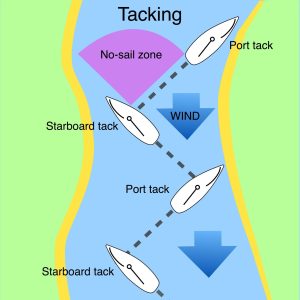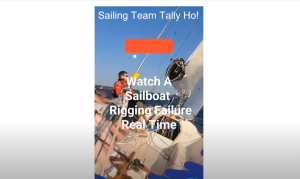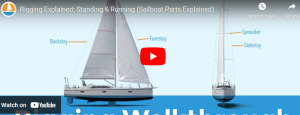Tacking is a fundamental sailing maneuver essential for navigating upwind and is a crucial skill for any sailor moving from intermediate to advanced levels. It involves changing the boat’s direction by turning the bow through the wind, shifting from one side (tack) to the other. In doing so, the sails switch from one side of the boat to the other, allowing the vessel to continue progressing against the wind.
From an intermediate or advanced sailor’s perspective, tacking isn’t just a means of turning but a nuanced technique that requires precision, timing, and keen awareness of factors like wind shifts, boat speed, and trim adjustments. Efficient tacking ensures minimal loss of speed during the maneuver, crucial for competitive sailors aiming to maintain momentum in a race.

Advanced sailors often look to refine each tack phase, focusing on smooth helm movements, sail adjustments, and the optimal angle to the wind. They also analyze conditions that influence the tack’s effectiveness, such as wave patterns and wind gusts, understanding how these factors can affect the boat’s momentum and positioning. Mastering this maneuver helps sailors sail closer to the wind, enhancing their overall ability to navigate various courses efficiently and competitively.

Understanding Tacking
Tacking is a vital sailing skill involving zigzagging against the wind to move in a desired direction. While it may initially seem counterintuitive to move diagonally rather than straight, skilled sailors understand the necessity of this maneuver. Similarly, in life, progress is not always linear. Challenges, represented by the opposing wind, often necessitate a strategic redirection.
Definition of Tacking
Tacking, in nautical terms, refers to the action of changing a sailing vessel’s direction by turning its bow through the wind. This maneuver allows a boat to make headway against the wind, which is essential for reaching a specific destination when the wind is blowing from the exact direction you need to go.
The Mechanics of Tacking
In practice, tacking involves shifting the sails and repositioning the rudder. The crew readjusts their positions to maintain balance, and the vessel pivots around the keel axis. This maneuver requires precise timing and coordination, ensuring the boat maintains momentum without stalling.

The Art of Making Life Changes
Life’s tacks are often subtle and gradual, requiring careful attention and action. Just As a Helmsman must be attuned to their surroundings, so too must one be mindful of the internal and external shifts that necessitate change.
Recognizing When to Tack
Identifying the right moment to tack involves observing the wind, sensing the boat’s speed, and anticipating future conditions. Figuring out when to make strategic changes in life is similar. It requires self-awareness, evaluation of current circumstances, and foresight.
Implementing Change with Precision
Executing a tack with precision involves a series of calculated actions. In life, implementing change is no different. It necessitates planning, taking deliberate steps, and adapting to new conditions smoothly. This approach mitigates potential disruptions and enhances the chances for success.
The Sailor’s Mindset: Embracing Ambiguity
Ambiguity is inherent in both sailing and life. The skilled helmsman recognizes this and embraces uncertainty as an opportunity for growth and exploration, rather than a threat.
Adapting to Uncertain Winds
Sedaris’s narrative style reflects the acceptance of uncertainty. By embracing the unexpected and viewing each complication as fodder for humor and insight, Sedaris exemplifies how to adapt to life’s unpredictable winds.
Resilience Through Adaptation
A sailor’s resilience lies in their adaptability. Adjusting sails, experimenting with angles, and weathering storms build strength and capability. Similarly, embracing ambiguity in life leads to resilience, derived from learning to navigate through diverse experiences.
Steering with Intent: Goal Orientation
While flexibility is essential, so is maintaining a clear sense of direction. A helmsman has a destination in mind, which guides their tactics and adjustments.
Setting Personal Direction
Determining a clear course in life—much like plotting a nautical map—helps maintain focus amidst constant adjustments. Goals provide direction; without them, even well-executed tacks may lead astray.
Balancing Flexibility and Focus
Sedaris often exemplifies the balance between flexibility in narrative shifts and the focus on thematic depth. In life, this balance ensures that while you adapt and maneuver your daily sails, you don’t lose sight of the overarching goals.
Table: Sailing Techniques vs. Life Strategies
| Sailing Technique | Corresponding Life Strategy |
|---|---|
| Tacking | Making gradual life changes |
| Using the Rudder | Steering decisions and actions |
| Adjusting Sails | Adapting to circumstances |
| Anticipating Wind | Foresight and planning |
| Navigating Currents | Embracing ambiguity |
Conclusion: Your Helmsman’s Journey
Navigating life effectively requires understanding and mastering the art of tacking—both literally and metaphorically. David Sedaris’s narrative compass points toward humor, resilience, and adaptability as essential tools for this journey. By learning to tack when needed, adjusting sails, and embracing the unpredictability of life’s winds, you steer with greater confidence and purpose, ultimately charting a course that aligns with your desires and aspirations.
In adopting this helmsman’s mindset, life’s challenges transform from daunting forces to winds that propel you toward your desired destination. Remember, each transition is an opportunity to reassess and recalibrate, ensuring smoother sailing on your unique voyage.





